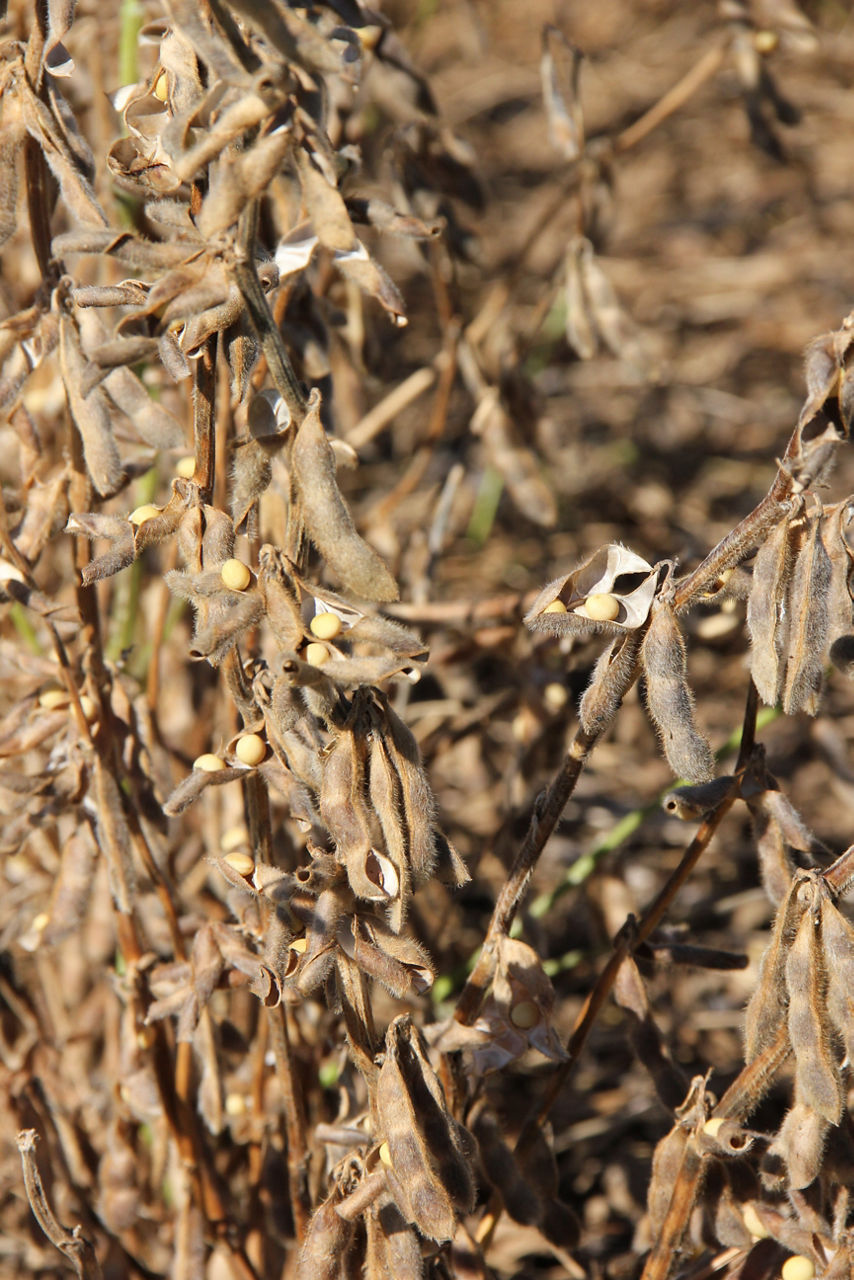Pod Shattering in Soybean
October 18, 2024
- Pre-harvest pod shattering can occur when pods weaken from adverse weather conditions or when harvest is delayed.
- Four loose seeds per square foot on the soil surface is equal to about one bushel per acre of lost yield potential.1
- Potential yield losses can be reduced with combine adjustments, timely harvest, and product selection.

Introduction
The soybean pod has a shell that encloses the central cavity where the seeds are contained. Along both sides of the length of the pod are seams (sutures) at which the pod opens when maturity is reached. Soybean pods can shatter along these seams due to any of several conditions, and pod shattering can affect the final yield. A loss of four seeds per square foot (seen as seeds on the soil surface) equals about one bushel per acre of yield loss.1,2
Causes
Weather. If dry mature pods are rehydrated from precipitation and then dried again, the cycles of wetting and drying may break down the attachment at the pod seams.1 The weakened seams may cause pods to break and open more easily. Drought conditions during pod maturation may also result in a weak pod structure that can make the pod more prone to cracking open.1,2 Additionally, hail earlier in the season may lead to empty, twisted pods at harvest.
Harvest Delay. Ideally, soybeans should be harvested at 13% seed moisture content, which results in the pods remaining intact.3 Shattering may occur if there is a long interval between maturation and harvest. The risk of shattering increases each day harvest is delayed past a week after maturity. This risk may be exacerbated if the same soybean product was planted across numerous fields and all the fields are ready for harvest at the same time.
Other Factors. Pod shattering may occur in fields with poor fertility or severe pod-feeding by grasshoppers and bean leaf beetles. Conditions that can accelerate soybean senescence, such as late-season spider mite infestations, can also increase pod shattering.
Management Solutions
Early Harvest. Harvest mature soybean fields as early as possible if pod shatter is an issue. To reduce pod shattering during harvest, start harvesting earlier in the day when plant material is still damp from overnight dew. Harvest as much of the crop as possible before the moisture level falls below 11% in order to reduce splits and cracked seed coats.3
Combine Adjustment. Slowing down the harvesting speed can reduce shatter and stubble losses. Soybean pods can be stripped from the stem, shattered, and dropped to the ground when harvested at high speeds. Refer to the manufacturer’s manual before performing any maintenance and to confirm that the correct settings are being used to minimize harvest losses.4
Product Selection. If pod shattering has been a consistent problem, soybean products should be selected for tolerance to shattering. The shattering response of a soybean product is measured after the product has been left in the field for about two weeks after maturity or about one week later than the optimum harvest time.5 To help reduce the risk of pod shattering due to overmature pods, avoid situations where all acres are ready to be harvested at the same time, such as when the same product was planted over a large number of acres. Select a variety of products with relative maturities (RM) that vary by three days for every week of harvest time required for your operation. Therefore, if soybean harvest takes two weeks, it is recommended to plant products with three or four different maturities that vary collectively in maturity by six days or more. This process may allow for the collective soybean crop to mature in such a way that harvest can be completed on a timely schedule.
Sources
1Lindsey, L. 2012. Watch out for shattering soybeans. Ohio’s Country Journal. http://ocj.com/2012/10/watch-out-for-shattering-soybeans/
2Conley, S. 2012. Drought induced shatter. University of Wisconsin–Madison. http://ipcm.wisc.edu/blog/2012/09/drought-induced-shatter/
3Hellevang, K. 2013. Soybean maturity, moisture variations may pose problems. North Dakota State University Extension. https://www.ag.ndsu.edu/news/newsreleases/2013/sept-23-2013/soybean-maturity-moisture-variations-may-pose-problems
4Hanna, M. 2012. Combine settings for drought. Iowa State University Extension, Integrated Crop Management News. https://crops.extension.iastate.edu/cropnews/2012/08/combine-settings-drought
5Schapaugh, W.T. 1997. Selection of soybean varieties. In, Soybean production handbook. Kansas State University Extension. C-449. https://www.harper.k-state.edu/crops-livestock/documents/Soybean.pdf
Web sources verified 10/17/24. 1310_466820